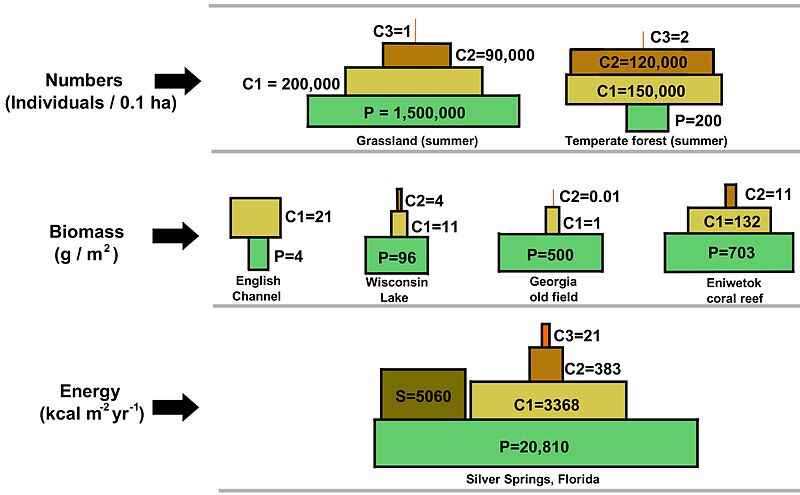Biomass Pyramid Definition, Types, Comparison, Importance Explained
Biomass pyramid is an ecologic concept whereby the total dry biomass at various trophic levels is depicted in a triangular diagram. This article discusses biomass pyramid definition, types, comparison, importance and disadvantages, as outlined below;
-Biomass Pyramid Definition: 4 Ways to Define the Pyramid of Biomass
-Pyramid of Biomass Vs Pyramid of Numbers Vs Pyramid of Energy
-Disadvantages of Pyramid of Numbers, Energy
-Importance of Biomass Pyramid Concept
-Pyramid of Biomass Disadvantages
Biomass Pyramid Definition: 4 Ways to Define the Pyramid of Biomass
The biomass pyramid is a variant form of the energy pyramid, that is used to depict or analyze the amount and flow of organic biomass within an ecosystem [3].
As the above definition implies, a biomass pyramid is meant to serve similar purpose as the energy pyramid which shows how bioenergy is transferred from one trophic level to another in the ecologic hierarchy of a given environmental system or biome.
In the biomass pyramid, bioenergy is replaced with biomass, which is simultaneously transferred through feeding interactions.
The presence of trophic levels is a distinctive characteristic that makes biomass pyramids similar to food chains. These levels are briefly acknowledged in the alternative biomass pyramid definition below;
Biomass pyramid is an ecological concept and diagram comprised of four to five levels that respectively represent producers, primary, secondary, tertiary and quaternary consumers; in terms of how biomass resources flow from one level to another.
Next, the biomass pyramid definition is outlined with due reference to some examples of biomass pyramids, that can be used to gain better understanding of the concept;
The pyramid of biomass is a polygonal, diagrammatic representation of the flow of organic matter among animals and plants in a biome, with examples including; soil-microbial biomass pyramid, inverted aquatic biomass pyramid, forest biomass pyramid, tundra biomass pyramid, and 5-level desert biomass pyramid.
Lastly, a biomass pyramid definition is given below which outlines the types of biomass pyramids;
Biomass pyramid refers to a concept that consists of trophic levels stacked together in a tapering polygonal hierarchy, which may come as any of two types including; upright biomass pyramid (of terrestrial ecosystems) and inverted biomass pyramid (of aquatic ecosystems).
Types of Pyramid of Biomass
Types of pyramid of biomass are; upright and inverted biomass pyramids respectively. Each of these two types is discussed briefly below;
1). Upright Biomass Pyramid (as one of the Types of Pyramid of Biomass)
Upright and inverted are the two types of biomass pyramids.
An upright biomass pyramid is one in which the total amount of biomass is highest at the bottom or lowest level, and consistently decreases in an upward direction.
The outcome of this decreasing-upward trend is a pyramid that sits upright; that is, by tapering upward, with an intersection-point at its top.
Upright biomass pyramids are used to represent ecosystems where the producers are largest in number and constitute the largest amount of organic matter, followed by the primary, secondary, tertiary, and quaternary consumers in sequential order.
Most terrestrial ecosystems like tundras, forests and prairies will produce an upright biomass pyramid because of the ability of plants (producers) to manufacture their own food from solar energy through photosynthesis, and the direct or indirect dependence of all other groups of organisms on these producers to produce their own biomass.
Upright biomass pyramids have the same general trend and geometric outline as energy pyramids.
For energy pyramids, the tapering-upward trend can be explained by what is often referred to as the 10 percent rule of ecological energy transfer (trophic transfer efficiency); whereby only ten percent of total energy in a given trophic level is successfully transferred to the immediate overlying level, as a result of metabolic and physicochemical processes that cause energy losses in the ecosystem [1].
Upright biomass pyramid is more conventional than the inverted biomass pyramid, whose occurrence is restricted to certain ecological systems and conditions.
2). Inverted Biomass Pyramid (as one of the Types of Pyramid of Biomass)
An inverted biomass pyramid is a graphical representation of organic matter-flow in ecologic systems where producers at the lowest trophic level, have the least amount of total biomass, and tertiary or quaternary consumers have the largest amount of total biomass [2].
The pyramid of biomass is inverted because consumers tend to grow larger than their prey in some ecosystems, so that the total organic mass of these consumers exceeds that of lower organisms, even when these lower organisms have larger population sizes.
An example of an inverted biomass pyramid is that which is established in an aquatic ecosystem such as a pond; where producers like algae and small aquatic plants are significantly smaller in individual and collective organic mass than consumers like small fish, which are smaller in total organic mass than large fish, and so forth.
It is important to note that energy pyramids are hardly ever inverted under natural conditions, because while organic mass may be smaller for prey than predators, the amount of energy available at a given consumer-level is always dependent on what is transferred upward from lower trophic levels.
The main difference between upright and inverted pyramids of biomass is the relative amount of total biomass in the trophic levels; so that upright pyramids feature larger total-biomass at lower levels, and inverted pyramids feature lower total-biomass at lower levels.
Below is a table that helps to distinguish between upright and inverted pyramids of biomass, in a summarized format;
Comparison Criteria | Upright Biomass Pyramid | Inverted Biomass Pyramid |
Trend | Tapering-Upward | Tapering-Downward |
Level of Largest Total Biomass | Lowest Trophic Level (1) | Highest Trophic Level (4, 5) |
Relation to Energy Pyramid | Proportional | Disproportional |
Depicted Ecosystem | Terrestrial | Aquatic |
Pyramid of Biomass Vs Pyramid of Numbers Vs Pyramid of Energy
A pyramid of numbers shows the number of individual organisms that occur in each of the trophic levels of a given ecosystem. It is often used alongside, and compared with, the pyramid of biomass.
The main idea behind the pyramids of biomass and numbers is to analyze ecosystems in terms of the relative organic size or magnitude of the various trophic levels.
Pyramid of biomass is a more accurate system than pyramid of numbers, because it evaluates relative organic size in terms of the total amount of organic matter in each trophic level, and eliminates errors that occur when numerous, small organisms are evaluated as having larger organic size than fewer but individually-larger organisms.
A pyramid of numbers is best used when there is emphasis on population size, species richness and/or biodiversity; as these parameters are based on numeric count rather than total mass.
The difference between pyramid of energy and pyramid of biomass is that pyramid of energy depicts the total amount of chemical bioenergy (ATP) that is present in the organic matter in a given trophic level, whereas pyramid of biomass depicts only the total amount of organic matter, with no reference to its energy content.
Since some kinds of organic matter tend to contain more bioenergy than others, it is possible for the energy pyramid of a given ecosystem to differ considerably in trend and geometry, from a biomass pyramid of the same ecosystem.
The difference between the pyramid of energy and the pyramid of numbers is that the pyramid of energy focuses on total bioenergy available at various trophic levels of an ecosystem; while the pyramid of numbers is concerned with the total number of organisms present at various trophic levels; which is not always proportional to total bioenergy.
Because pyramid of numbers depicts numeric values, they may not always take the form of a symmetrical pyramid, unless the values are depicted as ratios to one another. This is yet another attribute that differentiates numbers pyramid from energy and biomass pyramids respectively.

Disadvantages of Pyramid of Numbers, Energy
The disadvantages of pyramid of numbers are;
1. Pyramid of numbers is misleading in cases where both biomass and energy are not proportional to number of organisms
2. Geometric outline may be obtuse and fail to resemble a pyramid
3. Relative size of organisms is entirely excluded
4. Ecological complexities like omnivorous and multi-trophic behaviors of species are not accounted for
5. Population changes by death and reproduction can easily falsify evaluation
6. Analysis is oversimplified
7. Important abiotic factors like climate are not considered

The main advantage of pyramid of numbers is that it can be evaluated without destructive measures like elimination of organisms to measure mass, weight, or energy content.
A major disadvantage to the pyramid of energy is that using this pyramid can create the illusion of an overall tapering-upward trend for all variables in an ecosystem; as it fails to reveal the possibility of tapering-downward or irregular trends which can be seen when using biomass and numbers pyramids respectively.
Importance of Biomass Pyramid Concept
Importance of biomass pyramids includes;
1. Absolute depiction of organic mass distribution in ecosystems
2. Can also be used to deduce energy transfer trends
3. Reveals significant information about a given ecosystem when combined with numbers pyramid
In summary, the biomass pyramid is important for its role in showing how energy flow and biological productivity affect the amount of organic matter that is generated in am ecological system, and how this organic matter is distributed across the various levels of the ecologic hierarchy.
Pyramid of Biomass Disadvantages
Pyramid of biomass disadvantages are;
1. Loss of biomass by biodegradation can falsify analyses
2. Analysis procedure can be destruction and may require death of organisms
3. Amount of biomass is not necessarily representative of overall ecologic conditions
The advantages of biomass pyramid include that it is more accurate than the numbers pyramid, and may be proportional to energy distribution.
Conclusion
Biomass pyramid is a diagram that represents organisms at various trophic levels of an ecosystem, in terms of their total (dry) organic mass.
Types of pyramid of biomass are;
1. Upright Biomass Pyramid
2. Inverted Biomass Pyramid
The disadvantages of pyramid of numbers are; lack of symmetry, size and energy exclusion, and over-simplicity.
Importance of biomass pyramids includes; absolute organic mass-depiction and role in depicting energy and productivity conditions.
Pyramid of biomass disadvantages include; analyses falsification by biodegradation, possible death of organisms, and inconsistent proportionality of biomass to ecologic conditions.
Advantages of biomass pyramid include higher accuracy than numbers pyramid, and possible proportionality to energy distribution.
References
1). Barneche, D. R.; Hulatt, C. J.; Dossena, M.; Padfield, D.; Woodward, G.; Trimmer, M.; Yvon-Durocher, G. (2021). "Warming impairs trophic transfer efficiency in a long-term field experiment." Nature. 2021 Apr;592(7852):76-79. Available at: https://doi.org/10.1038/s41586-021-03352-2. (Accessed 11 April 2023).
2). Heathcote, A. J.; Filstrup, C. T.; Kendall, D.; Downing, J. (2016). "Biomass pyramids in lake plankton: influence of Cyanobacteria size and abundance." Inland Waters 6(2):250-257. Available at: https://doi.org/10.5268/IW-6.2.941. (Accessed 11 April 2023).
3). Trebilco, R.; Baum, J. K.; Salomon, A. K.; Dulvy, N. K. (2012). "Understanding Eltonian biomass pyramids with size-based ecological theory." 97th ESA Annual Convention 2012. (Accessed 11 April 2023).





